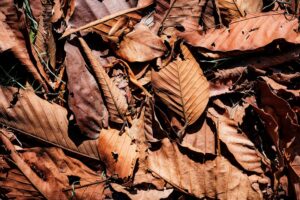 Written by Sue Crowley, Land Manager
Written by Sue Crowley, Land Manager
It is a coldish and rainy day with the wind blowing; the daylight is waning and leaves are floating to ground. For many people these leaves are beautiful and a welcome show before winter freeze and snow set in. However, as evidenced by our language, perhaps these pesky leaves are not our favorite-we have dubbed their collective presence on our yards and on the forest floor with the term, “leaf litter.” We spend hours trying to relocate leaves away from our yards. And as far as “debris” goes, we ecologists and foresters use the term “coarse woody debris” to describe trees that have fallen to ground and are now slowly decaying. Yet these fallen leaves, seeds, small twigs, branches and even whole trees make up an important layer on the ground just above the mineral soil.
The blanket layer (leaf litter) provides important habitat. It serves as a source of nesting materials for squirrels and birds; it supplies cover for mice and salamanders; and it enables seeds to shelter from hungry birds so the seeds will germinate in the spring. The blanket layer is home to many organisms like snails, spiders, and millipedes, but also fungi and bacteria. The cycle is quite brilliant as some will eat and breakdown the leaves into smaller bits. The smaller bits are decomposed further to eventually become mineral soil that contains vital nutrients such as nitrogen and calcium which will support the growth of trees, shrubs and other herbaceous plants.
The haven of a large, downed tree (coarse woody debris) that resides in the woods for many years is much like the blanket of leaves except that it is present for much longer before it is transformed into soil. The long life of a downed tree provides for storage of carbon, hiding places for small mammals, travel corridors under snow cover, substrate for fungi, and even a great place for a tree seed to start its life. Have you ever seen a tree that looks like it is on stilts? Well, that tree most likely began its life on a decaying log and the log has since decomposed into the soil.
I think the terms “litter” and “debris” do not give these vital aspects of our environment the proper credit for all they provide. Perhaps consider leaving a bit of a blanket in part of your yard or just recognizing a large log on the ground when you take a hike because they are a home to many and the source of good soil, nutrients and healthy forests now and in the future.
Photo credit: rawpixel.com
